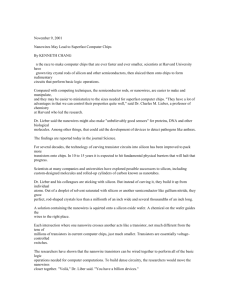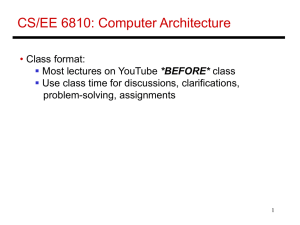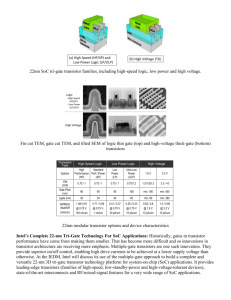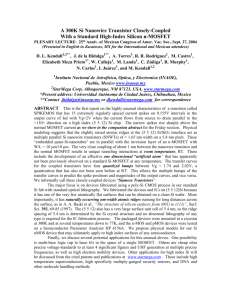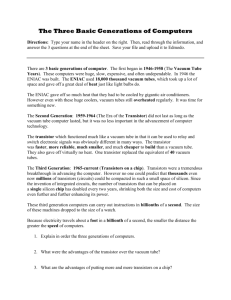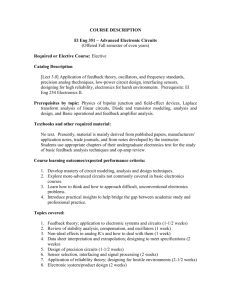Nanoscience
advertisement
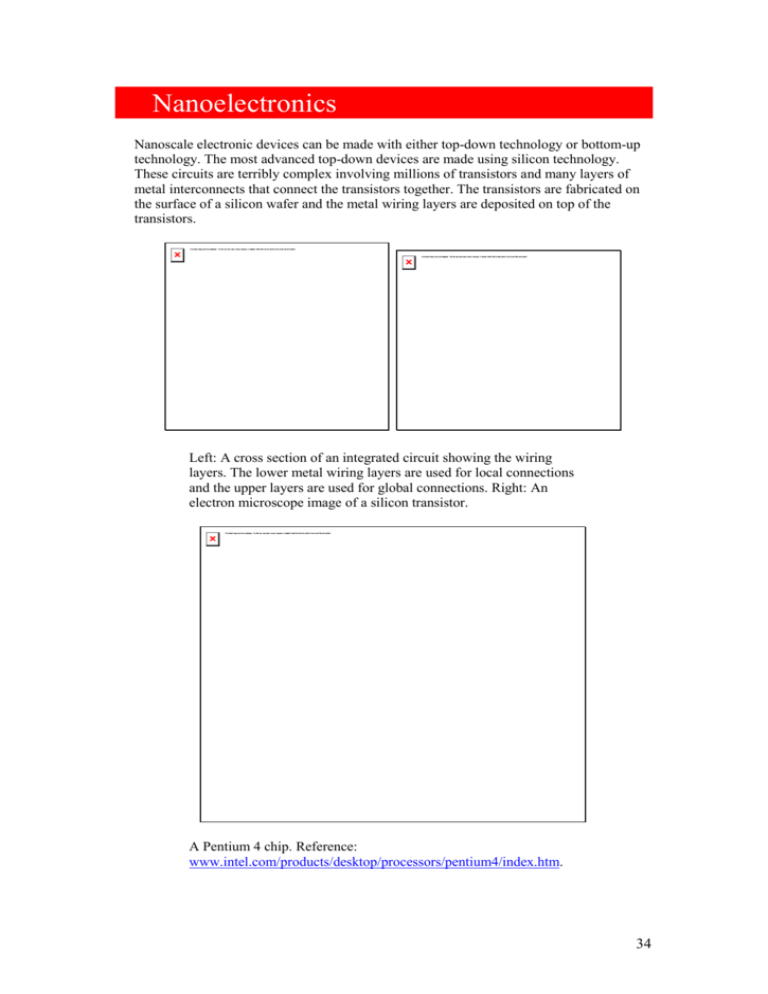
Nanoelectronics Nanoscale electronic devices can be made with either top-down technology or bottom-up technology. The most advanced top-down devices are made using silicon technology. These circuits are terribly complex involving millions of transistors and many layers of metal interconnects that connect the transistors together. The transistors are fabricated on the surface of a silicon wafer and the metal wiring layers are deposited on top of the transistors. Left: A cross section of an integrated circuit showing the wiring layers. The lower metal wiring layers are used for local connections and the upper layers are used for global connections. Right: An electron microscope image of a silicon transistor. A Pentium 4 chip. Reference: www.intel.com/products/desktop/processors/pentium4/index.htm. 34 The CMOS process steps. Reference: Prospects for Single Molecule Information Processing Devices, Yasuo Wada, Proceedings of the IEEE, Vol. 89 (2001). The dimensions of integrated circuits have been decreasing exponentially ever since they were first introduced in the 1960's. Every four years, the smallest features decrease by one half. The exponential decrease was first pointed out by Gordon Moore of Intel and is known as Moore's law. The smallest lateral features of integrated circuits fabricated today are 90 nm. It is expected that this shrinking will continue for another decade but exponential decreases in feature size cannot continue indefinitely. Transistors cannot be made smaller than atoms. The decreasing feature sizes in integrated circuits and the problems that need to be overcome to continue shrinking circuits are described in detail in the International Technology Roadmap for Semiconductors (ITRS roadmap). 35 Fig. 5.2. A table of chip characteristics from the ITRS roadmap. Recently there have been a number of articles in popular science journals claiming that silicon technology is facing insurmountable problems and it will soon be replaced by some other technology based on carbon nanotubes or molecular electronics. This is nonsense. Silicon technology is the dominant technology for information processing and there is no other technology that even comes close to delivering the same performance. Especially in high performance applications like microprocessors, silicon technology has no realistic challengers. This does not mean that there is no future for bottom-up technologies in electronics. In bottom-up electronics, electronic components like diodes or transistors are synthesized chemically and then arranged into circuits. Because the devices are synthesized chemically, the position of every atom in the device is known and the devices can be optimized on the atomic scale. Chemical synthesis is also a process that can be scaled up easily. Once it is possible to make transistors by chemical synthesis, more transistors will be made in one day than it will ever be possible to make by photolithography. After diodes and transistors are produced chemically, there will be great incentive to try to couple them into circuits by chemical means. Since so many devices can be produced simultaneously by chemical synthesis, the more complexity that can be included in a circuit chemically, the lower the costs of the final circuit will be. This could well be the successor to Moore's law. Instead of improving electronics by making the components smaller, we will start with atomically precise components and build ever more complex circuits out of them. 36 This somewhat futuristic vision of bottom-up electronics has lead to a flurry of research on chemically synthesized electronic components and self-assembly methods. Devices made of molecules, nanotubes, nanowires, nanocrystals, macromolecular assemblies, or collections of these structures have been studied. Bottom-up electronics is still in a primitive state and electronic devices fabricated by bottom-up techniques are not yet being widely used in applications. This is an exciting and rapidly developing field. Most of the results that are being published describe the fundamental electron transport mechanisms that occur in nanostructures. Unfortunately, sometimes the terminology can be confusing for someone new to the field. The words 'transistor' and 'electronics' don't always have the same meaning. Most books, articles, and conferences on "nanoelectronics" or "molecular electronics" are not really concerned with electronics in the conventional sense. Molecular electronics is a term that is usually used to describe the fundamental study of electrical current flow through molecules. The molecules may or may not have any practical circuit application. In this research community, a transistor is any three terminal device that modulates a current. Such a 'transistor' is often not a transistor at all from the electrical engineering point of view. The breakthroughs in nanoelectronics that we read about in popular science journals are typically breakthroughs in our understanding of electronic transport but not in electronics. At this point, how current flows through molecules is not very well understood and possibly the breakthroughs in electronic transport will lead someday to new developments in electronics. However, most popular journals over hype progress in our understanding of electronic transport and present it as advancements for electronics. Presumably this is done to increase magazine sales. Here is what Edwin A. Chandross said about the molecular electronics hype: Molecular electronics hype The proponents of this "technology" have buried us in hype for several years. They promised workstations that will operate for decades powered by only a small battery (1), 100 high-end workstations on a grain of sand (2), and, more recently, 1000 Pentiums on the same base (3). Although it has been admitted that logic will require devices with gain (4), no such molecular device has yet been identified. Such unreasonable advertising should have aroused the skepticism even of novices. Edwin A. Chandross Letter to Science , Science vol. 303, pp. 11361137 (2004). Serious questions about this field have been raised for several years after talks by proponents at American Chemical Society and Materials Research Society meetings. Results that are claimed to represent technology must be subjected to examination of manufacturability and device reliability, issues that have been nearly completely ignored. Any device that cannot be made reliably in the lab is unlikely to become the basis of a technology in 5 years, despite what Jim Heath said about molecular-based memory at the UCLA debate in September (5). Much of the present situation is a result of publication, primarily in the press, and of reports that do not include important experimental details. The lack of full papers is a prime characteristic of the field of molecular electronics, and this makes it impossible to fully evaluate the experiments. It is time to demand much more information. 37 Edwin A. Chandross MaterialsChemistry LLC, 14 Hunterdon Boulevard, Murray Hill, NJ 07974, USA. References 1. J. Heath, S. Williams, Chem. Eng. News 77, 6 (1999). 2. See www.chem.ucla.edu/dept/Faculty/heath/. 3. J. R. Heath, in Reducing the Time from Basic Research to Innovation in the Chemical Sciences: A Workshop Report to the Chemical Sciences Roundtable (National Academies Press, Washington, DC, 2003), pp. 56-63. 4. J. F. Stoddart, J. R. Heath, Chem. Phys. Chem. 3, 519 (2002). 5. Much of the UCLA debate is now available on the California Nanosciences Institute Web site (www.cnsi.ucla.edu/mainpage.html). A number of issues in molecular electronics are addressed in detail in my presentation. An interesting example of a transistor that is not really a transistor is the report of a transistor made using a single C60 molecule (Hongkun Park, Jiwoong Park, Andrew K. L. Lim, Erik H. Anderson, A. Paul Alivisatos, and Paul L. McEuen, "Nanomechanical oscillations in a single-C60 transistor," Nature 407 p. 57 (2000)). This article describes some excellent research on electronic transport through a C60 molecule. A single C60 molecule was placed between two metal electrodes and the current through the molecule was measured. The electron transport excited a bouncing ball mode where the C60 bounced on the substrate. Consequences of this vibration were observed in the current measurement. Fig. 5.3. The electrical characteristics of a C60 transistor. Reference: Hongkun Park, Jiwoong Park, Andrew K. L. Lim, Erik H. Anderson, A. Paul Alivisatos, and Paul L. McEuen, "Nanomechanical oscillations in a single-C60 transistor," Nature 407 p. 57 (2000). 38 The C60 transistor can also be evaluated for its suitability in circuit applications. There are several properties that a transistor should have. First of all, it should have signal gain. It must be possible to amplify the signal that represents the information in a circuit. Usually, a signal is represented by a voltage. In this case, the transistor should exhibit voltage gain. The voltage gain can be calculated from the published electrical characteristics. In this transistor, a signal is input at the gate, Vg, and the output appears across the source and drain electrodes. The output voltage is labeled V in the Fig. 5.3. The voltage gain is the change in the output voltage divided by a change in the input voltage at constant current. The maximum voltage gain seems to occur for gate voltages between 7.4 V and 7.7 V. In this region a change in gate voltage of 0.3 V causes a change in output voltage of about 10 mV. The voltage gain is thus 0.03. A gain smaller than 1 indicates that the transistor attenuates the signal instead of amplifying it. This transistor is thus not suitable for building complex circuits. Most molecular transistors do not exhibit voltage gain. In fact, the smallest transistors that do show voltage gain greater than 1 are silicon transistors. In circuits, the output of one transistor is often connected to the input of the next transistor. The output voltage of the C60 transistor is plotted in the range from -70 mV to +70 mV. These are the output voltages that could be used to drive the input of the next transistor. Unfortunately, the only gate voltages that are given in the figure are between 5.9 V and 7.7 V. From the circuit point of view, it would be more interesting to plot the response of the transistor for gate voltages between -70 mV and +70 mV because those are the only voltages that this device can generate. Figure 5.4 shows the current-voltage characteristics of a silicon transistor made by Intel. The distance between the source and drain electrodes in this case is 15 nm. Notice that the gate voltages plotted fall in the range of the source-drain voltage. This is the information that is needed to design circuits with the transistor. Fig. 5.4. The current-voltage characteristics of silicon transistor made by Intel. 39 Another important characteristic of a transistor is the leakage current. A transistor can be thought of as a sort of switch. For certain gate voltages the switch is closed and a current will flow between the source and drain electrodes. For other gate voltages the switch is open and ideally no current flows between the source and drain electrodes. Nevertheless, a small leakage current flows when the transistor is nominally open. Small transistors tend to have higher leakage currents than larger transistors because the source and drain electrodes are closer together in a small transistor. This leakage current dissipates energy and causes the circuit to heat up. The heat generated by the leakage current is one of the factors that limits the density of transistors in a circuit. The transistor density, n, times the leakage current, Ileak, times the voltage across the transistors is the power dissipated per unit area. An acceptable total power density is about 10 W/cm². Most of the power that is dissipated when the transistors are actively switching open and shut but a upper limit on the density of the transistors can be found by assuming that all of the transistors are open and the only power dissipation is due to the leakage current. This can be expressed as the inequality, n < 10/(IleakVsupply) [transistors/cm²]. A typical supply voltage is about 1 V and silicon circuits have already reached densities of 100M transistors/cm². This puts an upper limit on the leakage currents of a few nanoamps. The drive current of a transistor is also an important characteristic to consider. This is the current that the transistor can deliver when the switch is closed. Voltage levels are often used to represent information in electronics and the time it takes to change the voltage of a wire from one voltage to another is capacitance of the wire times the voltage difference divided by the drive current of the transistor that is charging the wire. The higher the drive current, the faster the electronics. The drive current in silicon electronics is about 1 mA. This drive current has been maintained even as the transistors have been made smaller. The capacitance of the components decreases as they become smaller and the supply voltage can be decreased which has resulted in an increase in the switching speed as transistors have been made smaller. Most non-silicon transistors that have been investigated have a significantly lower drive current than 1 mA. Either more of these transistors would have to be used in parallel to achieve the same circuit speed or the circuits will be significantly slower than what is possible with silicon transistors. Plastic electronics The term molecular electronics is sometimes applied to devices made from organic semiconductors. This is also called plastic electronics. The idea is to develop organic conductors, semiconductors, and insulators that can be easily processed. These materials can be stamped or printed to electronic circuits. The goal is to produce electronic circuits as quickly and as cheaply as printing a full color page. Organic semiconductors typically have charge carrier mobilities 100 to 10000 times lower than crystalline silicon devices. This means that to make a device that is provides the same current drive as a silicon transistor, the organic device has to be 100 to 10000 times larger. This fact combined with the limited resolution of cheap printing processes results in slow devices with much lower densities than those achieved by silicon technology. However, there are some applications like smart price tags where plastic electronics are useful. Another conceivable application of plastic electronics is to make inexpensive displays. As of January 2004, the most complicated plastic electronic circuits contain about 2000 transistors and operate at a switching speed of 5kHz. The individual transistors have a channel length of 2.5 μm and a width of about 500 μm. For more details see the publication: Flexible active-matrix displays and shift registers based on solution-processed organic transistors, G. H. Gelinck, H. Edzer A. Huitema, E. Van Veenendaal, E. Cantatore, L. Schrijnemakers, J. B. P. H. Van Der Putten, T. C. T. Geuns, M. Beenakkers, J. B. Giesbers, B.-H. Huisman, E. J. 40 Meijer, E. Mena Benito, F. J. Touwslager, A. W. Marsman, B. J. E. Van Rens and D. M. de Leeuw, Nature Materials 3, pp.106-110 (2004) doi: 10.1038/nmat1061. Electronics on a flexible substrate. Molecular Memories It has often been remarked that molecular memories will probably be made before logic circuits and much progress has been made lately. In one approach, molecules are sandwiched between a parallel set of wires running vertically and a parallel set of wires running horizontally. Some molecules can assume two conformations and it is possible by applying voltage pulses to the molecules to switch between these conformations. If the molecule has a low electrical resistance in one conformation and a high electrical resistance in another conformation, one bit of information can be stored in the molecule. This information can be read out by measuring the resistance of the molecule. The information storage is non-volitile; the information is not lost when the power to the memory chip is turned off. Rotaxane molecules can assume two configurations. One has a low electrical resistivity and the other has a high resistivity. This can be used to build a molecular memory. 41 In this scheme it is important that the molecules have a nonlinear current-voltage characteristic like a diode. This is necessary so that the information from an individual molecule can be read. Suppose that a large current flows through the molecule if it is in one conformation when 1 V is applied across it, little current flows across it if is in the other conformation and little current flows through the molecule when 0.5 V is applied across it in either conformation. Then if one vertical wire is held at -0.5 V and one horizontal wire is held at +0.5 V while all of the other wires are held at 0 V, only the molecule at the intersection of the wires to which voltage has been applied will determine the current that flows. Of course, when 0.5 V is applied across the molecules there will be a small leakage current. This leakage current will limit the size of the array because the current through all of the leaking molecules must be less than the current through the molecule that is intended to be read. Carbon nanotube transistors Carbon nanotubes have been used to make transistors. Nanotubes can carry very high current densities. Left: An AFM image of a carbon nanotube transistor. Right: An artist's impression of a carbon nanotube transistor. Semiconducting nanowires Semiconducting nanowires are cylindrical single crystals with a diameter of 10 nm - 100 nm and a length of several microns. It is possible to grow complex three-dimensional semiconducting structures in nanowires with sub nanometer precision. Different materials can be combined in nanowires in layers and shells to define p-n junctions, quantum dots, or one-dimensional conducting channels. The large surface to volume ratio of semiconducting nanowires make them attractive for applications as sensors and for contacts. Prototype transistors, logic circuits, light-emitting diodes, and lasers have been made with these nanowires. One possible route to applications is to develop processes where many nanowires can be fabricated cheaply and then arrange these components into circuits. For instance, diodes can be made from semiconducting nanowires and then these diodes can be aligned in solution using the same kinds of mechanisms that form cell membranes. The many diodes in parallel could then be transferred onto an electrode to make lighting panels or solar cells. Nanowires could also be used to make transistors in large area electronics where the channel of a transistor would consist of many nanowires in parallel. Flow assembly could be used to align the nanowires. In this case, the nanowires would compete with plastic 42 electronics where applications such as electronic paper, smart packaging, and sensors require cheap circuits on flexible substrates. The combination of nanowire LEDs and nanowire transistors could potentially be used to produce cheap and high quality displays. Another route towards applications would be incorporate semiconducting nanowires in silicon technology. In nanowires, it is possible to epitaxially grow materials on top of each other that do not grow epitaxially in large areas. This is because the cross section of the nanowires is so small that less strain is built up and larger lattice mismatches are possible. This makes it possible to incorporate more materials in silicon circuits than would otherwise be possible. This may provide a route to incorporate III-V optical devices in silicon. The properties such as the band gap of a semiconductor can be tuned by changing the diameter of the nanowires. This gives further flexibility in the fabrication of optical devices using nanowires. The large surface-to-volume ratio of nanowires makes them potentially useful for making low ohmic contacts and it could be useful for integrating sensitive sensors with silicon circuits. A nanowire consisting of InAs layers and InP layers. The transmission electron microscope picture on the right shows that the periodicity of the atomic lattice is maintained across the interfaces between the two materials. Reference: Onedimensional heterostructures in semiconductor nanowhiskers, M. T. Björk, B. J. Ohlsson, T. Sass, A. I. Persson, C. Thelander, M. H. Magnusson, K. Deppert, L. R. Wallenberg, and L. Samuelson, Applied Physics Letters, Vol. 80, pp. 10581060, (2002). Self-assembled circuits Modern silicon circuits that are produced by top-down technologies have very complicated architectures and it is difficult to see how this sort of complexity could be achieved by self-assembly. A self-assembled circuit would likely have a simple, regular architecture. 43 This can perhaps be best explained by giving some examples. Suppose we wanted to build a cheap display that would self-assemble itself. The display would consist of many identical pixel elements, each capable of exchanging information with its neighbors and displaying color information. These pixel elements would be designed so that, under the right conditions, they arrange themselves into a two-dimensional planar array. Image information would then be passed to some random pixel near the lower left corner. The image information would specify the color that should be displayed and the position (x,y) where that color should be displayed. Each element would be programmed to subtract 1 from the x coordinate and pass the information to the right and to subtract 1 from the y coordinate and pass the pass the information up. If an element receives information with the coordinates (0,0), that element displays the color information. In this architecture, there is no complex wiring, only nearest neighbor connections. No pixel element knows its position yet it displays the correct information. The elements could be powered by sandwiching them between two planar electrodes that act as power and ground. If the elements were produced purely by chemical synthesis, large cheap displays could be made. A memory could be made using similar elements to those described above but instead of displaying the information, small chunks of information would be stored in each element. The information would be stored until a request for that information was passed to the element to pass the information to the edge of the array where it could be read. If a global signal were given that every element should pass their current information to the right and receive new information from the left, large amounts of information could be written into or read out of the memory quickly. A real breakthrough in memory storage would be achieved if this kind of memory could be made using a three-dimensional array of elements. A self-assembled processor could be based on the same principles. A processor element would store two kinds of information, data and instructions. The processing element would manipulate the data based on the instructions and pass information to its neighbors. In architectures such as this consisting of many identical elements, it is easier to implement error correction and fault tolerance since every element can take on the duties of any other element. It is also conceivable that nanomachines could be made that implement repairs by replacing faulty elements with new ones. Bottom-up nanoelectronics has not yet matured to the stage that it is possible to fabricate the pixel elements, memory elements or processor elements described here. Present research on bottom-up electronics is still at the stage of trying to manufacture individual devices like transistors. Combining these devices into circuits will have to wait until more is known about the devices. References A very influential paper that is often cited as the first to discuss using molecules as electronic components is A. Aviram and M. A. Ratner, "Molecular rectifiers," Chem. Phys. Lett. Vol. 29 pp. 277-283 (1974). Gordon Moore, Cramming More Components Onto Integrated Circuits, Electronics, April 19, 1965. Computing with Molecules - A Scientific American article by Mark Reed and James Tour. Hybrid Semiconductor-Molecular Nanoelectronics by Konstantin Likharev. Molecules Get Wired - The "Breakthrough of the year 2001" in Science magazine. 44 Scaling CMOS to the limit - Special issue of the IBM Journal of Research and Development Vol. 46, Nos. 2/3, 2002. Electronics below 10 nm - by Konstantin Likharev. HP announces molecular electronics breakthrough IOP PhysicsWeb September 2002. Electronics using hybrid-molecular and mono-molecular devices, C. Joachim, J. K. Gimzewski and A. Aviram, Nature 408 p. 541 (2000). Prospects for Single Molecule Information Processing Devices, Yasuo Wada, Proceedings of the IEEE, Vol. 89 (2001). Carbon Nanotube Electronics, Ph. Avouris, J. Appenzeller, R. Martel, and S. J. Wind, Proceedings of the IEEE, Vol 91 p. 1772 (2003). Molecular electronics: from devices and interconnect to circuits and architecture, M.R. Stan, P.D. Franzon, S.C. Goldstein, J. C. Lach, M. M. Ziegler, Proceedings of the IEEE, Vol 91 p. 1940 (2003). Fabrication, Assembly, and Characterization of Molecular Electronic Components, B. A. Mantooth and P. S. Weiss, Proceedings of the IEEE, Vol 91 p. 1772 (2003). Limits to binary logic switch scaling-a gedanken model, V. V. Zhirnov, R. K. Cavin, J. A. Hutchby, G. I. Bourianoff, Proceedings of the IEEE, Vol 91 p. 1934 (2003). High Performance Silicon Nanowire Field Effect Transistors, Yi Cui, Zhaohui Zhong, Deli Wang, Wayne U. Wang, and Charles M. Lieber, Nano Letters, 3 (2), 149 -152, 2003. Britney's Guide to Semiconductor Physics MOLECULAR ELECTRONICS: Next-Generation Technology Hits an Early Midlife Crisis, Robert F. Service, Science Volume 302, pp. 556-559 (2003). Conductance Switching in Single Molecules Through Conformational Changes, Z. J. Donhauser, B. A. Mantooth, K. F. Kelly, L. A. Bumm, J. D. Monnell, J. J. Stapleton, D. W. Price, Jr., A. M. Rawlett, D. L. Allara, J. M. Tour, and P. S. Weiss, Science vol. 292 pp. 2303-2307 (2001). MOLECULAR ELECTRONICS: Nanodevices Make Fresh Strides Toward Reality, Robert F. Service, Science vol. 302 p. 1310 (2003). More on Molecular electronics, Edwin A. Chandross, Science vol. 303, pp. 11361137 (2004). Problems 1. A carbon nanotube transistor allows 1 μA of current to pass through it when it is switched on and 10 pA leaks through it when it is switched off. The voltage across the transistor is 1 volt. The output of the transistor charges a wire with a capacitance to ground of 1 fF. How many of these transistors could be placed in 1 cm2? How long will it take the transistor to change the voltage on the wire at the output by 1 volt? 2. DNA has an information density of about 1 Gigabit/meter. By laying DNA strands next to each other, a bit density of 1014 bits/cm2 would be possible. This kind of bit density should be achievable with molecular memories. You could read the bits for instance with an STM. If information were stored in three dimensions, the bit density would be about 1021 bits/cm3. How would you read these bits? If you think it is impossible to store (and be able to read) 1021 bits/cm3, what three dimensional bit density would be possible? 45

